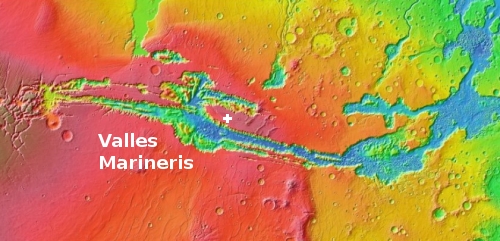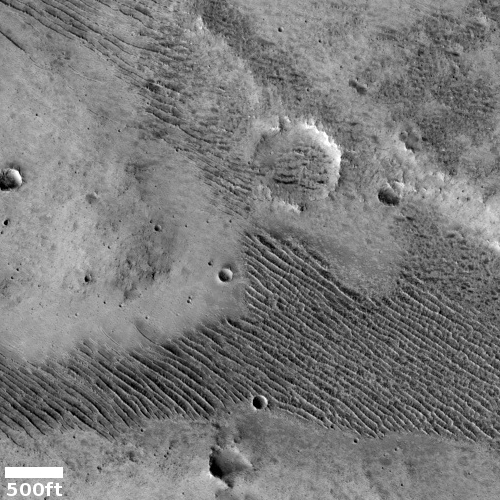Strange ridge ripples on the windswept plateau above Mars’ biggest canyon
Today’s cool image is once again another of what I dub a “what the heck?” photo. The picture to the right, cropped to post here, was taken on December 17, 2020 by the high resolution camera on Mars Reconnaissance Orbiter (MRO) and captures some very strange ridges on the plateau above Mars’ biggest canyon, Valles Marineris.
The image, labeled merely as a “terrain sample,” was taken not as part of any specific research project but scheduled by MRO’s science team in order to maintain the camera’s temperature. When they do this they try to take pictures covering something interesting, but often it is a potshot that sometimes shows little of interest.
In this case the photo shows something very strange. The ridges in the sample are packed into one area only, but if you look at the full image you will see that they are also scattered about randomly and sometimes isolated on the flat plains surrounding this spot.
Interestingly, these ridges resemble the first “What the heck?” image I ever posted in 2019. That photo was located at about the same elevation as these ridges, but due west in the volcanic plains near Mars’s giant volcanoes and just off the western edge of the overview map below.

The white cross marks the location of these ridges, located in the isolated plateau formed by two branches of the giant Valles Marineris canyon.
With both today’s image and the 2019 one, the ridges are aligned, and only appear in patches.
At first glance the consistent ridge alignment suggests they might have been carved by some form of wind erosion, based on the long term direction of the prevailing winds. However, they do not look like sand dunes, as they are sharp and jagged. Moreover, if these are some form of ripple dunes, why are they found in patches, in some places but not others?
Maybe volcanism was involved in forming these ridges, though my limited geological knowledge is unaware of any volcanic process that might result in aligned ridges such as these.
I am sure a deep dive into the published literature of Martian geology will find some paper proposing an explanation, but for now I simply present these to my readers, so that you can scratch your heads as I do.
On Christmas Eve 1968 three Americans became the first humans to visit another world. What they did to celebrate was unexpected and profound, and will be remembered throughout all human history. Genesis: the Story of Apollo 8, Robert Zimmerman's classic history of humanity's first journey to another world, tells that story, and it is now available as both an ebook and an audiobook, both with a foreword by Valerie Anders and a new introduction by Robert Zimmerman.
The print edition can be purchased at Amazon or from any other book seller. If you want an autographed copy the price is $60 for the hardback and $45 for the paperback, plus $8 shipping for each. Go here for purchasing details. The ebook is available everywhere for $5.99 (before discount) at amazon, or direct from my ebook publisher, ebookit. If you buy it from ebookit you don't support the big tech companies and the author gets a bigger cut much sooner.
The audiobook is also available at all these vendors, and is also free with a 30-day trial membership to Audible.
"Not simply about one mission, [Genesis] is also the history of America's quest for the moon... Zimmerman has done a masterful job of tying disparate events together into a solid account of one of America's greatest human triumphs."--San Antonio Express-News
Today’s cool image is once again another of what I dub a “what the heck?” photo. The picture to the right, cropped to post here, was taken on December 17, 2020 by the high resolution camera on Mars Reconnaissance Orbiter (MRO) and captures some very strange ridges on the plateau above Mars’ biggest canyon, Valles Marineris.
The image, labeled merely as a “terrain sample,” was taken not as part of any specific research project but scheduled by MRO’s science team in order to maintain the camera’s temperature. When they do this they try to take pictures covering something interesting, but often it is a potshot that sometimes shows little of interest.
In this case the photo shows something very strange. The ridges in the sample are packed into one area only, but if you look at the full image you will see that they are also scattered about randomly and sometimes isolated on the flat plains surrounding this spot.
Interestingly, these ridges resemble the first “What the heck?” image I ever posted in 2019. That photo was located at about the same elevation as these ridges, but due west in the volcanic plains near Mars’s giant volcanoes and just off the western edge of the overview map below.

The white cross marks the location of these ridges, located in the isolated plateau formed by two branches of the giant Valles Marineris canyon.
With both today’s image and the 2019 one, the ridges are aligned, and only appear in patches.
At first glance the consistent ridge alignment suggests they might have been carved by some form of wind erosion, based on the long term direction of the prevailing winds. However, they do not look like sand dunes, as they are sharp and jagged. Moreover, if these are some form of ripple dunes, why are they found in patches, in some places but not others?
Maybe volcanism was involved in forming these ridges, though my limited geological knowledge is unaware of any volcanic process that might result in aligned ridges such as these.
I am sure a deep dive into the published literature of Martian geology will find some paper proposing an explanation, but for now I simply present these to my readers, so that you can scratch your heads as I do.
On Christmas Eve 1968 three Americans became the first humans to visit another world. What they did to celebrate was unexpected and profound, and will be remembered throughout all human history. Genesis: the Story of Apollo 8, Robert Zimmerman's classic history of humanity's first journey to another world, tells that story, and it is now available as both an ebook and an audiobook, both with a foreword by Valerie Anders and a new introduction by Robert Zimmerman.
The print edition can be purchased at Amazon or from any other book seller. If you want an autographed copy the price is $60 for the hardback and $45 for the paperback, plus $8 shipping for each. Go here for purchasing details. The ebook is available everywhere for $5.99 (before discount) at amazon, or direct from my ebook publisher, ebookit. If you buy it from ebookit you don't support the big tech companies and the author gets a bigger cut much sooner.
The audiobook is also available at all these vendors, and is also free with a 30-day trial membership to Audible.
"Not simply about one mission, [Genesis] is also the history of America's quest for the moon... Zimmerman has done a masterful job of tying disparate events together into a solid account of one of America's greatest human triumphs."--San Antonio Express-News



I love your “What the heck?” postings, Robert!
Considering the two sites you’ve pointed to here — the present one in the ridge astride Valles Marineris and your first posting in that genre from 2019 which you pointed to — the 2019 one in particular exhibits a series of ridges which are not only parallel to each other, but which, repeatedly hundreds of times, fork off sub-ridges at right angles. Is that typical behavior for sand dunes?
Looking at the very first “what the heck” picture, it seems to be an example of whatever process causes the “glass tubes on Mars” effect. This photo, not so much, as it’s occuring on an essentially flat plain. Logic suggests it must be caused by some sort of flow in one direction, be it water, wind, ice, Martian magma….. I also have absolutely no idea! What the heck!?!?;